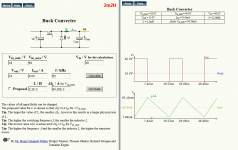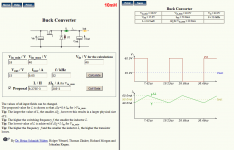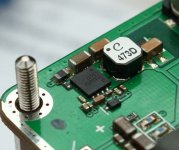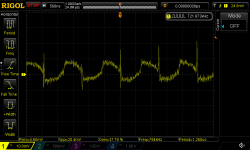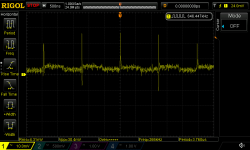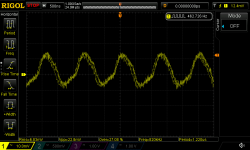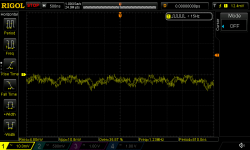Hello,
Can somebody recommend this board?
Klasse D TPA3255 MINI HIFI AUDIO Digitale Versterker Boord 300 W + 300 W DC50V in Klasse D TPA3255 MINI HIFI AUDIO Digitale Versterker Boord 300 W + 300 W DC50V van Versterker op AliExpress.com | Alibaba Groep
I am looking for an fan-less option for 18" open baffle speaker (bass only, active crossover). I have a Crown XLi but the fan is always on.. Tried other amps but none sounds as good as Crown. I want to try a class D (cheap one).
Thanks!
Mine played a week. 😀
Hello,
Can somebody recommend this board?
I have a couple of those. First its important to note they don't have the -HV variant of the buck regulator. So 40V is about as high as you can take them without separating the buck input from the TPA3255 output power rail.
Secondly, the inductor value is wrong at 22uH. I reckon from the DS for the regulator it should be 2.2mH. And the output caps chosen aren't in accord with the DS recommendations.
finally
Too my luck no major damage was done to the DDDAC 12 Volt power supply when the transformer lead wire broke of from the PSB, so after getting the original transformator back onto the PSB, and after checking the output volts of the PSU, (OK) the music was playing again.
I do get some hun and hiss when no music is playing from the combo the hiss is coming from the WaveIO board (USB to I2S), the hum I am not sure, I think I need to twists some more wires in my DAC wiring layout, ( The hum was there before the issue with the power supply ).
Very nice listening, serving the music from computer via Audirvana Plus to the DDDAC via USB, like before much more open / brilliance as when playing from iPod, no listening fatigue , just lovely music from the KEF LS50.
I did also test a second setup (above is a 4 deck DDDAC (with red mainboard), this setup is Raspberry PI 3 with a HiFiBerry Digi+ Pro HAT, connected via I2S to a single deck DDDAC (tent labs PSU) and blue main board.
This setup misses the hiss coming from the Wave IO board in the other DAC, both setups share the same power supply and output configuration ( Cinemags ).
The software on the Raspberry PI 3 is MoodeAudio Moode Audio Player for Raspberry Pi
Music served from computer via ethernet to Moode Audio Player ( version 8.3, on the Raspberry PI 3 ), this is the setup I listened too most of the time.
The base line of the story, this TPA 3255 EVM is a very nice, easy to implement board to integrate into a system playing some good quality music.
What needs to be resolved however is the issue with the startup/shutdown thumbs (they are loud), when you do not use the reset switch, I believe there is a solution for this somewhere in this forum.
Happy listening
Bert
Finally, update about listening with the DDDAC 1794.The test with the DDDAC 1794, will take a little longer.
Long story, short, way back, I modified the 12 Volt supply of the DDDAC with a bigger Trafo (xformer), and on initial testing (listening for a few minutes) the stiff wires from the trafo to the PSU main board "broke" off, bad soldering / plan from my side 😱
...
Too my luck no major damage was done to the DDDAC 12 Volt power supply when the transformer lead wire broke of from the PSB, so after getting the original transformator back onto the PSB, and after checking the output volts of the PSU, (OK) the music was playing again.
I do get some hun and hiss when no music is playing from the combo the hiss is coming from the WaveIO board (USB to I2S), the hum I am not sure, I think I need to twists some more wires in my DAC wiring layout, ( The hum was there before the issue with the power supply ).
Very nice listening, serving the music from computer via Audirvana Plus to the DDDAC via USB, like before much more open / brilliance as when playing from iPod, no listening fatigue , just lovely music from the KEF LS50.
I did also test a second setup (above is a 4 deck DDDAC (with red mainboard), this setup is Raspberry PI 3 with a HiFiBerry Digi+ Pro HAT, connected via I2S to a single deck DDDAC (tent labs PSU) and blue main board.
This setup misses the hiss coming from the Wave IO board in the other DAC, both setups share the same power supply and output configuration ( Cinemags ).
The software on the Raspberry PI 3 is MoodeAudio Moode Audio Player for Raspberry Pi
Music served from computer via ethernet to Moode Audio Player ( version 8.3, on the Raspberry PI 3 ), this is the setup I listened too most of the time.
The base line of the story, this TPA 3255 EVM is a very nice, easy to implement board to integrate into a system playing some good quality music.
What needs to be resolved however is the issue with the startup/shutdown thumbs (they are loud), when you do not use the reset switch, I believe there is a solution for this somewhere in this forum.
Happy listening
Bert
Earlier in the week I decided to leave it on overnight just to see if it sounded different being left on. Things got busy and it ended up being two days later and I was quite surprised at how much smoother the amp sounded. It's a nice sonic improvement.
If it uses 7 or 8 watts at idle it's OK to do that every now and again.
I haven’t shut mine off for weeks.
Secondly, the inductor value is wrong at 22uH. I reckon from the DS for the regulator it should be 2.2mH. And the output caps chosen aren't in accord with the DS recommendations.
Yes, it might be of interest how a 10mH inductor will do as it highly reduces ripple current. With 22uH in place the converter is running in DCM, so smoothing highly depends on output caps.
Buck Converter
will help you out, i showed with 50mA average current.
Attachments
arcgotic, I think you will be much happier with this board! I love mine! TPA3255 2x260 Watt 1%THD+N Class D Audio Amplifier | eBay
Hi, doctormord
 !
!
== With 22uH in place the converter is running in DCM, so smoothing highly depends on output caps. ===
- Please, Is that mean, that it's NO matter to haver about 22microHenry, if use "Good enough, Big enough" Cap on output???? How Big for this place- for Your opinion are???
Thanks!

== With 22uH in place the converter is running in DCM, so smoothing highly depends on output caps. ===
- Please, Is that mean, that it's NO matter to haver about 22microHenry, if use "Good enough, Big enough" Cap on output???? How Big for this place- for Your opinion are???
Thanks!
Most likely yes, due to low load current. The 15V are then passed into an LDO for 12V so any ripple is attentuated. I.e. when using the LM2940, like on the EVM, the ripple rejection at 52KHz is better than 65dB.
(Btw. DCM provides better efficiency at light loads than CCM)
(Btw. DCM provides better efficiency at light loads than CCM)
Last edited:
The 15V are then passed into an LDO for 12V so any ripple is attentuated. I.e. when using the LM2940, like on the EVM, the ripple rejection at 52KHz is better than 65dB.
(Btw. DCM provides better efficiency at light loads than CCM)
Great you posted those helpful pages showing the ripple. Now if you did an FFT of the two cases (small inductor vs big) you'd get many more higher order harmonics from the small inductor instance due to the slopes being much steeper. Hence PSRR @ 52kHz doesn't help much in determining what'll come out of the LM2940.
I don't get your point. You may want to show your FFT results and maybe your measurements for this particular case? The LM2940s output isn't directly connected to any sensitive part. And what about those higher harmonics, do they get down-modulated) at some point into the audible range? (Having k2 at 104kHz which fits nicely into ESR minimum of modern lowESR caps)
I have no FFT results because I don't need to, eyeballing the waveforms is sufficient to note that the waveform with the lower valued inductor is more impulsive. More impulsive implies higher levels of higher harmonics. What the LM2940 is connected to is not relevant to this analysis.
True, as seen on the plots above but i still don't see the practical problem here. DCM is not a bad thing per definition and is used widely to keep efficiency high at light loads. If it doesn't contribute to audible artefacts or produce any "noise" where's the benefit?
I'm not saying there is a practical problem, just pointing out that the output of LM2940 is going to have more higher frequency harmonics on it with a smaller inductor than with (say) 2.2mH. I haven't looked at its PSRR plot but they all degrade at higher frequency don't they?
Given the choice between efficiency and potential SQ issues, I'll chose slightly lower efficiency. Based on my own recent experience of feeding a buck reg into an ADC (a huge loss of subjective dynamics) I prefer to use passive (LC) filters these days rather than rely on PSRR of a reg. I didn't take any measurements in that instance so I dunno if the loss of subjective dynamics can be quantified.
Given the choice between efficiency and potential SQ issues, I'll chose slightly lower efficiency. Based on my own recent experience of feeding a buck reg into an ADC (a huge loss of subjective dynamics) I prefer to use passive (LC) filters these days rather than rely on PSRR of a reg. I didn't take any measurements in that instance so I dunno if the loss of subjective dynamics can be quantified.
Right, that's all valid in theory and might get relevant with "bad" board layout or other quirks. We actually use 1.4-2MHz buck-regulators on our 3255 boards with no further ldo or bulky elyth/polymer caps with no issues or measurable performance/SQ degradation. (Of course 52kHz isn't 1400+kHz)
From your earlier posts it sounded like it is "a must" to change the (wrong) inductor due to SQ issues in this particular implementation.
From your earlier posts it sounded like it is "a must" to change the (wrong) inductor due to SQ issues in this particular implementation.
We actually use 1.4-2MHz buck-regulators on our 3255 boards with no further ldo or bulky elyth/polymer caps with no issues or measurable performance/SQ degradation. (Of course 52kHz isn't 1400+kHz)
Now you've piqued my curiosity - 'SQ degradation' relative to what alternative?
It wld be really wonderful if 2Mhz Buck Regulator doesnt cause any issue; however Audeo reported that Alientek D8 did use a 2Mhz Buck Regulator, and reportedly that does generates noisy hiss, he resorted to using 15uH to get rid of it.
My most recent experience is with a ~1MHz boost reg, that definitely needed passive filtering not to generate the same noisy hiss into my DAC's analog circuitry and that circuitry is discrete (no opamps).
Now you've piqued my curiosity - 'SQ degradation' relative to what alternative?
Compared to a buck circuit with additional filtering at the output + LDO and LC/RC filtering.
Actual implementation for 3255 with LM5017 (up to 100V) generating +/-12V in fly-bluck for AFE and input stage:
Tests where initially done at 850kHz and showed the following:
+AVCC at converters output cap:
-AVCC at converters output cap:
Using a (not necessary) small 47uF cap for the AFE module smoothens out the peaks:
+AVCC:
-AVCC:
I wouldn't cal 30mV peaks an issue with modern opamps.
Attachments
Last edited:
- Home
- Amplifiers
- Class D
- TI TPA3255EVM

